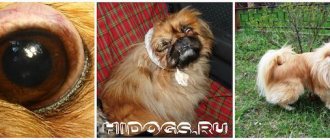Cute, tiny dogs bring their owners a lot of joyful emotions. However, the vulnerability of their health keeps the same owners in constant good shape. When it comes to scratching an animal, the first thing that comes to mind for owners of other breeds is fleas and other skin parasites. The answer to the question why a Chihuahua itches, in addition to this reason, implies many others.
The cause of the disturbing itching and its treatment are prescribed by a veterinarian. Painful scratching can be caused by external causes, or may be a consequence of a disease of the internal organs. In order not to start the disease, it is better to consult a specialist.
Possible Sources of Itchy Skin in Chihuahuas
The main causes of painful scratching in a pet include:
- the presence of skin parasites: fleas, ticks, lice, lice;
- allergic, drug-induced or infectious dermatitis;
- fungal infection;
- bacterial infection;
- deficiency of vitamin A and other microelements;
- blockage of the anal glands;
- presence of helminths;
- psychological reasons;
- pathology of internal organs - diabetes, liver disease, renal failure.
It is better to prevent or neutralize any disease at the very beginning. Owners should carefully monitor their pet’s behavior and, if their Chihuahua has painful itching, take action.
Non-food allergies (Atopy)
SITES OF LOCALIZATION
“Atopy” is an allergic reaction to everything else except food. For pollen, dust mites, flowers, chemical components contained in detergents, and much more.
Symptoms:
- Severe skin itching, causing great discomfort to the animal.
— Skin damage, scratching, abrasions (especially in the area of the muzzle and paws), which appear due to the fact that the dog constantly itches and tears the skin with its claws. An infection that gets into the wounds provokes the appearance of boils, hyperpigmentation, and ulcers.
- Hair loss, alopecia.
— A characteristic smell from the ears, reminiscent of fermented yeast dough.
— Focal lichenification is a structural change in the skin.
Additional signs of atopic dermatitis include:
- excessive dryness of the skin;
- immediate reaction to the allergen;
- external form of allergic otitis;
- superficial manifestations of staphylococcal infection.
The severity of the disease is determined by factors such as the area of skin lesions, the duration of exacerbations and remissions.
Treatment:
1. Corticosteroids are required. These drugs are hormonal, their action is aimed at eliminating itching, allergic swelling, and redness. Prednisolone, Methylprednisolone, Dexamethasone, etc. are most often prescribed.
2. The doctor also prescribes antihistamines: Lominal, Zyrtec, Claritin.
3. For old dogs, it is advisable to prescribe Telfast, Gismanal, Trexil - third and fourth generation drugs.
4. Tricyclic antidepressants are sometimes prescribed - Amitriptyline, Pyrazidol, Trimipramine.
5. Cyclosporine, Oxpentiphylline, Misoprostol or Fluoxetine will help cope with itching.
============================================================================================================================================================================================
Effects of itching and scratching on dogs
Even if a Chihuahua is constantly itching, at first there are no visible consequences. Dogs' skin is quite dense and protected by hair. After some time, the animal will begin to shed heavily, as the fur will begin to break and fall out from constant exposure.
Unprotected skin becomes thinner, peels, and scratches appear on it. The wounds are inseminated with fungal spores, and infection gets there. Next, inflammation is inevitable, which the animal’s immunity will selflessly begin to “fight.”
If the cause of the itching is not eliminated, the immune system begins to malfunction. Then, the path to any disease is open.
Ignoring something as minor as constant scratching can be fatal for your family pet.
Food allergies
PLACES OF LOCALIZATION
Food allergies occur to new components in food. Either it is proteins, or fats, grains, vitamins.
Symptoms:
- Severe skin itching. The dog constantly scratches his skin and ears, and tries to literally “rub his eyes” with his paws.
- The ears and eyes “run”, the dog develops a characteristic sweetish-sweet smell, which gradually intensifies. The discharge is initially liquid and colorless, but when infected it becomes purulent. Brown masses accumulate in the ears, yellowish ones in the corners of the eyes, especially noticeable after sleep.
— Skin scratches merge into bright pink spots, and a semblance of dandruff appears.
- Then the hair begins to fall out (alopecia areata).
— The next stage is the transition of dry eczema to weeping; The skin under the armpits, in the groin, and around the anus is affected.
— Digestive problems: loss of appetite and lethargy, rumbling in the stomach, diarrhea.
— Putrid odor from the mouth, foamy vomit mixed with bile, then swelling of the small intestine (reactive enteritis) and its obstruction increases.
Treatment:
1. Selection of hypoallergenic food, where the source of protein is lamb, duck or salmon, carbohydrates are corn and rice. For older dogs, a diet low in zinc, phosphorus and sodium is recommended.
2. Use of systemic antihistamines and anti-inflammatory drugs to eliminate itching and swelling.
3. Use of ointments and creams with a desensitizing and wound-healing effect.
4. Bathing the animal using shampoos containing corticosteroids, cooling and soothing components.
5. Prescription of systemic and local antibacterial and antifungal agents to combat secondary microflora.
============================================================================================================================================================================================
Scratching in puppies: when to sound the alarm
For children, including canine ones, any health problem can be dangerous. The puppy may sometimes rub his ear or neck, there is nothing wrong with that. However, you must definitely find out why your Chihuahua puppy is itching. If the scratching becomes intense, the itching does not give the baby rest, and scratching will appear on the skin.
A baby who has not yet been taken outside can bring skin parasites from the “parental” family. It is necessary to carefully examine the skin and hair to identify them.
When the hairs are broken off where they were scratched and look as if they were cut with dull scissors, the hair eater must have “worked hard”. This ectoparasite resembles a louse in appearance, but has a more massive head and mouthparts. It feeds on particles of animal skin and fur. The presence of dandruff in a dog is one of the signs of lice infestation.
On the guard hairs of the animal you can see white ovoid dots - these are eggs that lice lay. Blood-sucking small insects that are yellowish or gray in color. A louse that parasitizes a dog is not dangerous to other animals or humans. Just like cat parasites, for example, will not live in a puppy’s fur.
The danger of fleas, in addition to the anxiety caused by bites, is that they lay eggs not on the animal's body. A “secluded” place can be carpeting, cracks behind the baseboard or in ceramic tiles. A flea can go without food for several weeks, waiting for the right moment to jump on its victim.
Ticks begin to pose a danger to a baby Chihuahua only when they start walking outside.
How can you be sure there are no parasites?
Only a veterinarian can rule out the presence of parasites 100%. Most often, the following signs indicate the presence of fleas:
- Scabies : the animal itches, constantly changing position and angle. He clicks his teeth, as if trying to “catch” someone out of the fur.
- Dots on the skin : white - larvae, black - adult insects, red - flea bites.
- Dermatitis. Forms on the surface of the skin due to severe irritation or scratching.
Note! You can detect fleas using a simple test: place the dog in a basin or bathtub, leaving only the animal's head dry. Fleas do not live under water, and accordingly they will move to the top of the animal's head in search of a safe place.
Less obvious reasons why your Chihuahua itches
When the owners notice that the Chihuahua is itching, but there are no fleas and no other parasites are observed, allergies and psychological causes must be ruled out.
- Allergic reaction – itching. The most common type of allergy is food. Most often it occurs when an animal eats something that, in principle, should not be food for a dog: chocolate, smoked meats, spices, pickles. You cannot introduce several new products into food at once - only one at a time. After administration, you need to observe your pet for several days, and only after making sure that there is no reaction to complementary foods, introduce the next ingredient. Allergies can also be to medications, dog cosmetics, odors, and insect bites.
- Psychological causes of itching
. Stress can cause the body to react. Moving an animal to another home, a long absence of the owners or one of them, physical punishment of the animal are the most common causes of stress for Chihuahuas.
Prevention of allergic reactions
To reduce the risk of developing allergies, you must:
- avoid eating potentially hazardous foods (chicken, eggs, oatmeal, wheat, corn and other grains);
- feed the dog high-quality dry food;
- regularly drive away worms using specific drugs;
- use only special dog shampoos and cosmetics;
- do not feed the dog food from the owner’s table;
- try to use a minimum amount of household chemicals when cleaning the house;
- buy dog clothes only from natural materials;
- Avoid walking in areas where allergenic plant species grow.
In what cases is a veterinarian urgently needed?
There are no visible reasons for the itching, but the dog does not just scratch occasionally, but does it constantly and intensely. A specialist must identify the problem and prescribe treatment. In addition to diseases of the internal organs, which can only be diagnosed in a veterinary clinic, there are also causes of painful itching invisible to the owner’s eye.
Demodectic mange is caused by the demodex mite, which is almost impossible to see with the naked eye. The microscopic parasite lives in the animal's fur follicles. Demodex is always present in small quantities on the animal's skin. Against the background of exhaustion of the immune system or its unstable functioning (in puppies), the tick population is growing rapidly. Demodectic itching brings incredible suffering to the pet - he cannot sleep, play, develop normally, and his appetite decreases.
Ringworm is a fungal disease that is dangerous not only for the pet, but also for its owners. It is dangerous because the first ten days of the disease are asymptomatic. Afterwards, a ring-shaped spot forms on the skin, framed by small bubbles with a yellowish liquid. Ringworm treatment takes a long time and is problematic. You won't be able to get rid of it on your own.
Anal gland blockage is a condition that causes severe itching in the tail and anus area. In a healthy dog, these glands empty together with bowel movements, releasing secretions. Due to internal diseases, the secretion fluid becomes too thick and clogs the gland. “In response” it swells and itches painfully. The itching is so unbearable that some dogs literally ride on their butts on asphalt or carpet in an attempt to relieve it.
Parasitic insects
In spring and summer, dog owners experience a “headache” in the form of parasites – fleas and ticks, lice, or lice. Currently, pet stores offer a wide range of products against annoying insects.
However, veterinarians note that even the most expensive drugs do not provide 100% protection against uninvited guests. Veterinary clinics annually record outbreaks of encephalitis and a number of other deadly infectious diseases.
In addition to external parasites, ear mites pose a serious danger. Lack of treatment leads first to otitis media and then to complete deafness. If your pet's ear is constantly itching, this most likely indicates ear mites.
In addition to itching, the parasite can cause pain and discomfort. The pet shakes its head, rubs against furnishings, whines and loses its appetite. You can get rid of the misfortune with special means that are prescribed by the veterinarian for each dog individually.











